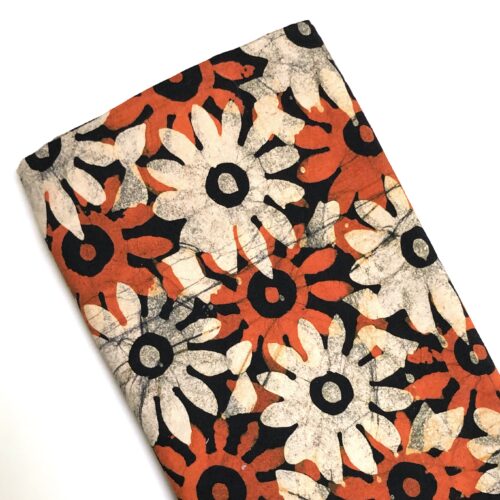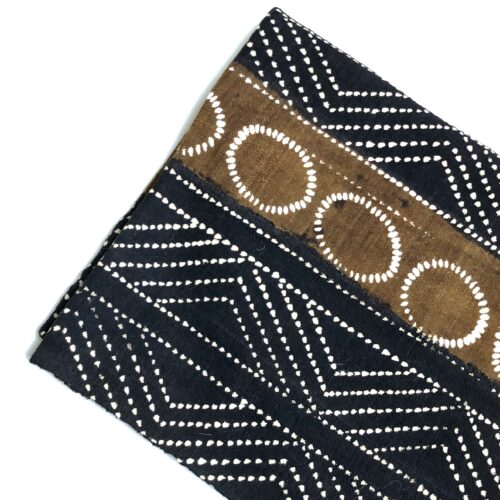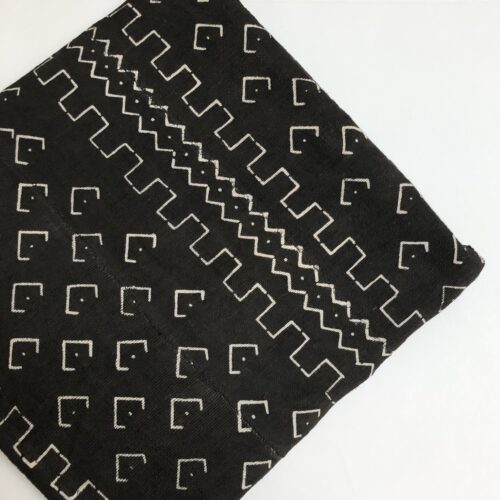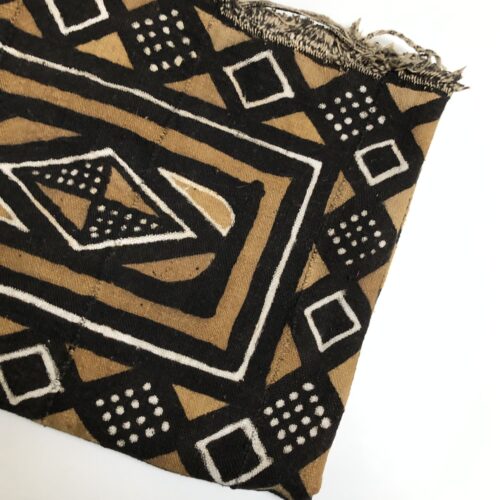-
Out of stock

 Royal Blue Batik Fabric handmade in Ho, Ghana, West Africa bought directly from the Batik Artisans . There are two yards available of this 100% cotton fabric. Ghana is well known for its gorgeous batik fabrics. $20 / 2 yards
Royal Blue Batik Fabric handmade in Ho, Ghana, West Africa bought directly from the Batik Artisans . There are two yards available of this 100% cotton fabric. Ghana is well known for its gorgeous batik fabrics. $20 / 2 yards -
Out of stock

 Orange and white Flowers on Black Background Batik Fabric handmade in Ho, Ghana, West Africa bought directly from the Batik Artisans . There are two yards available of this 100% cotton fabric. Ghana is well known for its gorgeous batik fabrics. $20 / 2 yards
Orange and white Flowers on Black Background Batik Fabric handmade in Ho, Ghana, West Africa bought directly from the Batik Artisans . There are two yards available of this 100% cotton fabric. Ghana is well known for its gorgeous batik fabrics. $20 / 2 yards -

 A gorgeous piece of Mudcloth found in Bolgatanga, Ghana. The Trader told me the mudcloth was handmade in Mali probably the Western Sahara region. The term “mudcloth” is loosely translated from Bambara, the language spoken in Mali. “Bògòlanfini” as it is called in Bambara, combines three root words: “bogo” meaning earth or mud, “lan” meaning ‘with’, and “fini” meaning cloth. The handmade Malian cloth dyed using fermented mud, giving it its name-sake. The tradition dates back to the 12th century. This piece of Mudcloth is made in the traditional way with 7 strips sewn together and measures 64"x44" . There are two alternating patterns as shown in last image. One pattern with circles is light brown and white. The other pattern with zigzags is dark brown and white. This cloth is hand made so will have some imperfections and colour variations which adds to its charm.
A gorgeous piece of Mudcloth found in Bolgatanga, Ghana. The Trader told me the mudcloth was handmade in Mali probably the Western Sahara region. The term “mudcloth” is loosely translated from Bambara, the language spoken in Mali. “Bògòlanfini” as it is called in Bambara, combines three root words: “bogo” meaning earth or mud, “lan” meaning ‘with’, and “fini” meaning cloth. The handmade Malian cloth dyed using fermented mud, giving it its name-sake. The tradition dates back to the 12th century. This piece of Mudcloth is made in the traditional way with 7 strips sewn together and measures 64"x44" . There are two alternating patterns as shown in last image. One pattern with circles is light brown and white. The other pattern with zigzags is dark brown and white. This cloth is hand made so will have some imperfections and colour variations which adds to its charm. -

 A gorgeous Traditional Smock .... with a modern twist! Hand made with hand stiching with beautiful Ghanaian batik fabric in patchwork pattern. Funky Frog is selling this traditional Smock for a favourite Trader, Ibrahim. All money will go directly to him. He asks $200 US for this magnificent piece of art. "The African Fugu Batakari jacket or smock is perhaps the most distinctive traditional garment from West Africa. Although this type of smock is most popular in Northern Ghana, it has gained acceptance and significance throughout the nation. The Fugu was introduced in Ghana by the Moshies from Burkino Faso and by the Hausas from northern Nigeria, both of whom migrated into Northern Ghana. The name Fugu comes from the Moshie word for cloth. The Dagombas call the garment Bingba, and in the south they call it Batakari. These smocks represent a powerful heritage."
A gorgeous Traditional Smock .... with a modern twist! Hand made with hand stiching with beautiful Ghanaian batik fabric in patchwork pattern. Funky Frog is selling this traditional Smock for a favourite Trader, Ibrahim. All money will go directly to him. He asks $200 US for this magnificent piece of art. "The African Fugu Batakari jacket or smock is perhaps the most distinctive traditional garment from West Africa. Although this type of smock is most popular in Northern Ghana, it has gained acceptance and significance throughout the nation. The Fugu was introduced in Ghana by the Moshies from Burkino Faso and by the Hausas from northern Nigeria, both of whom migrated into Northern Ghana. The name Fugu comes from the Moshie word for cloth. The Dagombas call the garment Bingba, and in the south they call it Batakari. These smocks represent a powerful heritage." -

 A gorgeous piece of Mudcloth found in Bolgatanga, Ghana. The Trader told me the mudcloth was handmade in Mali probably the Western Sahara region. The term “mudcloth” is loosely translated from Bambara, the language spoken in Mali. “Bògòlanfini” as it is called in Bambara, combines three root words: “bogo” meaning earth or mud, “lan” meaning ‘with’, and “fini” meaning cloth. The handmade Malian cloth dyed using fermented mud, giving it its name-sake. The tradition dates back to the 12th century. This piece of Mudcloth is made in the traditional way with 12 strips sewn together and measures 88"x60" . The dark brown with white designs pattern shown in image is repeated throughout. This cloth is hand made so will have some imperfections and colour variations which adds to its charm.
A gorgeous piece of Mudcloth found in Bolgatanga, Ghana. The Trader told me the mudcloth was handmade in Mali probably the Western Sahara region. The term “mudcloth” is loosely translated from Bambara, the language spoken in Mali. “Bògòlanfini” as it is called in Bambara, combines three root words: “bogo” meaning earth or mud, “lan” meaning ‘with’, and “fini” meaning cloth. The handmade Malian cloth dyed using fermented mud, giving it its name-sake. The tradition dates back to the 12th century. This piece of Mudcloth is made in the traditional way with 12 strips sewn together and measures 88"x60" . The dark brown with white designs pattern shown in image is repeated throughout. This cloth is hand made so will have some imperfections and colour variations which adds to its charm. -

 A gorgeous piece of Mudcloth found in Bolgatanga, Ghana. The Trader told me the mudcloth was handmade in Mali probably the Western Sahara region. The term “mudcloth” is loosely translated from Bambara, the language spoken in Mali. “Bògòlanfini” as it is called in Bambara, combines three root words: “bogo” meaning earth or mud, “lan” meaning ‘with’, and “fini” meaning cloth. The handmade Malian cloth dyed using fermented mud, giving it its name-sake. The tradition dates back to the 12th century. This piece of Mudcloth is made in the traditional way with 7 strips sewn together and measures 85"x42" . There are two alternating patterns in light brown, dark brown and white as shown in last image. This cloth is hand made so will have some imperfections and colour variations which adds to its charm.
A gorgeous piece of Mudcloth found in Bolgatanga, Ghana. The Trader told me the mudcloth was handmade in Mali probably the Western Sahara region. The term “mudcloth” is loosely translated from Bambara, the language spoken in Mali. “Bògòlanfini” as it is called in Bambara, combines three root words: “bogo” meaning earth or mud, “lan” meaning ‘with’, and “fini” meaning cloth. The handmade Malian cloth dyed using fermented mud, giving it its name-sake. The tradition dates back to the 12th century. This piece of Mudcloth is made in the traditional way with 7 strips sewn together and measures 85"x42" . There are two alternating patterns in light brown, dark brown and white as shown in last image. This cloth is hand made so will have some imperfections and colour variations which adds to its charm. -

 A gorgeous piece of Mudcloth found in Bolgatanga, Ghana. The Trader told me the mudcloth was handmade in Mali probably the Western Sahara region. The term “mudcloth” is loosely translated from Bambara, the language spoken in Mali. “Bògòlanfini” as it is called in Bambara, combines three root words: “bogo” meaning earth or mud, “lan” meaning ‘with’, and “fini” meaning cloth. The handmade Malian cloth dyed using fermented mud, giving it its name-sake. The tradition dates back to the 12th century. This piece of Mudcloth is made in the traditional way with 13 strips sewn together and measures 65"x50" . The pattern is a bold zigzag in the light brown, dark brown and white. This cloth is hand made so will have some imperfections and colour variations which adds to its charm.
A gorgeous piece of Mudcloth found in Bolgatanga, Ghana. The Trader told me the mudcloth was handmade in Mali probably the Western Sahara region. The term “mudcloth” is loosely translated from Bambara, the language spoken in Mali. “Bògòlanfini” as it is called in Bambara, combines three root words: “bogo” meaning earth or mud, “lan” meaning ‘with’, and “fini” meaning cloth. The handmade Malian cloth dyed using fermented mud, giving it its name-sake. The tradition dates back to the 12th century. This piece of Mudcloth is made in the traditional way with 13 strips sewn together and measures 65"x50" . The pattern is a bold zigzag in the light brown, dark brown and white. This cloth is hand made so will have some imperfections and colour variations which adds to its charm. -
Out of stock

 A gorgeous Traditional Bingba Smock .... Bingba is the name of the fabric. It is similar to Kente Cloth. Kente Fabric is what is made in southern Ghana and and this fabric is the equivalent of Kente for the Northerners in Ghana. The Smock is a large size. Either to be worn or the Smock would look fabulous as a Wall Hanging!!! The soft colours of Turquoise, Orange and off White would look so amazing on a large wall ... the fabric is hand woven and the garment is completely handmade with a lot of hand stitching. Funky Frog is selling this traditional Smock for a favourite Trader, Ibrahim. All money will go directly to him. He asks $200 US for this magnificent piece of art. "The African Fugu Batakari jacket or smock is perhaps the most distinctive traditional garment from West Africa. Although this type of smock is most popular in Northern Ghana, it has gained acceptance and significance throughout the nation. The Fugu was introduced in Ghana by the Moshies from Burkino Faso and by the Hausas from northern Nigeria, both of whom migrated into Northern Ghana. The name Fugu comes from the Moshie word for cloth. The Dagombas call the garment Bingba, and in the south they call it Batakari. These smocks represent a powerful heritage."
A gorgeous Traditional Bingba Smock .... Bingba is the name of the fabric. It is similar to Kente Cloth. Kente Fabric is what is made in southern Ghana and and this fabric is the equivalent of Kente for the Northerners in Ghana. The Smock is a large size. Either to be worn or the Smock would look fabulous as a Wall Hanging!!! The soft colours of Turquoise, Orange and off White would look so amazing on a large wall ... the fabric is hand woven and the garment is completely handmade with a lot of hand stitching. Funky Frog is selling this traditional Smock for a favourite Trader, Ibrahim. All money will go directly to him. He asks $200 US for this magnificent piece of art. "The African Fugu Batakari jacket or smock is perhaps the most distinctive traditional garment from West Africa. Although this type of smock is most popular in Northern Ghana, it has gained acceptance and significance throughout the nation. The Fugu was introduced in Ghana by the Moshies from Burkino Faso and by the Hausas from northern Nigeria, both of whom migrated into Northern Ghana. The name Fugu comes from the Moshie word for cloth. The Dagombas call the garment Bingba, and in the south they call it Batakari. These smocks represent a powerful heritage."




